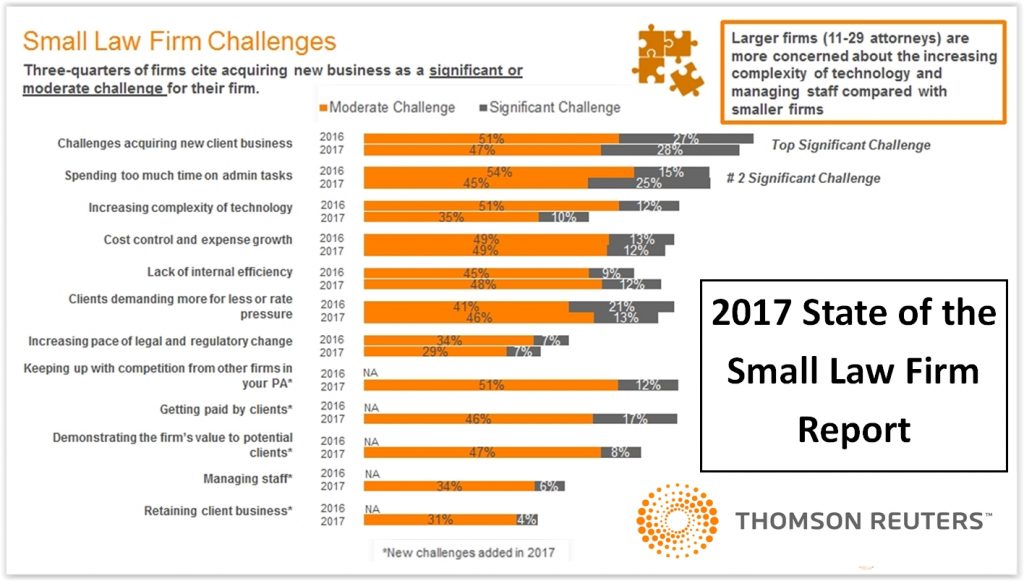Lawyers in solo and small firms face many challenges, chief among them being acquiring new business, according to the soon-to-be-published 2017 State of U.S. Small Law Firms survey conducted by Thomson Reuters.
Recently in my column at Above the Law, I gave an overview of the survey, which polled more than 300 law firms ranging in size from solos to 29 attorneys. Today I want to go into more depth on the survey’s findings regarding the challenges facing small firms and how they are responding to those challenges.
(You can sign up now to receive a copy of the survey when it is available, which I believe will be this week.)
Seventy-five percent of lawyers say getting new clients is either a moderate or significant challenge, with 28 percent saying it is a significant challenge. The second greatest challenge they face is spending too much time on administrative tasks, with 70 percent of lawyers saying it is either a moderate or significant challenge and 25 percent say it is a significant challenge.
Other top challenges small firms rate as either moderate or significant are:
- Getting paid by clients, 63%.
- Keeping up with competition from other firms in your practice areas, 63%.
- Cost control and expense growth (e.g. costs related to real estate or salaries), 60%.
- Lack of internal efficiency 60%.
- Clients demanding more for less or rate pressure from clients, 59%.
- Demonstrating the firm’s value to potential clients, 56%.
- Increasing complexity of technology, 45%.
- Managing staff, 40%.
- Increasing pace of legal and regulatory change 35%.
- Retaining client business, 35%.
When the responses are broken down by size of firm, the top-listed challenges change slightly. For solos, the top three challenges remain the same as the overall results above:
- Acquiring new client business, 74%.
- Spending too much time on administrative tasks, 67%.
- Getting paid by clients, 65%.
For firms of 2-6 lawyers, the top three challenges are:
- Acquiring new client business, 78%.
- Spending too much time on administrative tasks, 76%.
- Clients demanding more for less or rate pressure from clients, 68%.
Among firms of 7-29 lawyers, the top three are:
- Cost control and expense growth, 75%.
- Acquiring new client business, 73%.
- Keeping up with competition from other firms in your practice areas, 66%.
Few Have Made Changes
Although firms recognize the challenges they face, few have implemented changes to address them. For example, of firms that identify finding new clients as a challenge, only 29% have implemented changes to address this challenge. Of firms that identify client pressure to reduce rates as a challenge, 80 percent say they have not implemented changes. Across the board with respect to the challenges firms list, 66-80 percent of firms have not implemented changes to address them.
But the picture is not quite so bleak as those numbers would make it seem. While only a small percentage of firms have implemented changes to address their challenges, many other firms say they have plans in place to address the challenges, but which they have not yet implemented. For example, of firms that say finding new clients is a challenge, while only 29% have implemented changes to address the issue, another 34% say they have a plan in place to address it.
Thus, when you combine the numbers for firms that have either implemented changes or that have plans in place, the numbers of firms that are addressing their challenges range from roughly half to two-thirds:
- Challenges acquiring new client business, 63%.
- Getting paid by clients, 65%.
- Demonstrating the firm’s value to potential clients, 65%.
- Keeping up with competition from other firms in your practice areas, 54%.
- Lack of internal efficiency, 55%.
- Spending too much time on administrative tasks, 47%.
- Cost control and expense growth, 54%.
- Managing staff, 68%.
- Clients demanding more for less, 42%.
- Increasing complexity of technology, 52%.
- Retaining client business, 67%.
- Increasing pace of legal and regulatory change, 46%.
In addressing some of these challenges, solos are notably behind other small firms, the survey shows. The greatest gulf is in addressing the increasing complexity of technology. While only 31 percent of solos are addressing this challenge in any way, 60% of 2-6 lawyer firms and 64% of 7-29 lawyer firms are addressing it.
Other areas where solos are doing less to address challenges are:
- While 49% of firms with 7-29 lawyers are addressing the challenge of clients demanding more for less, just 36% of solos are.
- With regard to the increasing pace of legal and regulatory change, 59% of firms with 7-29 lawyers are addressing it, while 40% of solos are.
- The challenge of too much time spent on administrative tasks is being address by 56% of firms with 2-6 lawyers and 48% of firms with 7-29 lawyers, but just 39% of solos.
One challenge that solos seem to be addressing better than other small firms is the lack of internal efficiency. Sixty-two percent of solos say they are addressing this, compared to 51% of 2-6 lawyer firms and 53% of 7-29 lawyer firms.
This is the second year Thomson Reuters conducted the survey. I reported on last year’s survey in a series of posts here and at Above the Law. In last year’s posts, I gave an overview of the survey and then covered what the survey found about small firms’ greatest challenges and what they’re doing to address them, how small firms measure success, and the kinds of technology small firms are using. My final post last year looked at how solos differ from other small firm lawyers.
Again this year, I plan to write further posts reporting on specific aspects of the survey.
 Robert Ambrogi Blog
Robert Ambrogi Blog